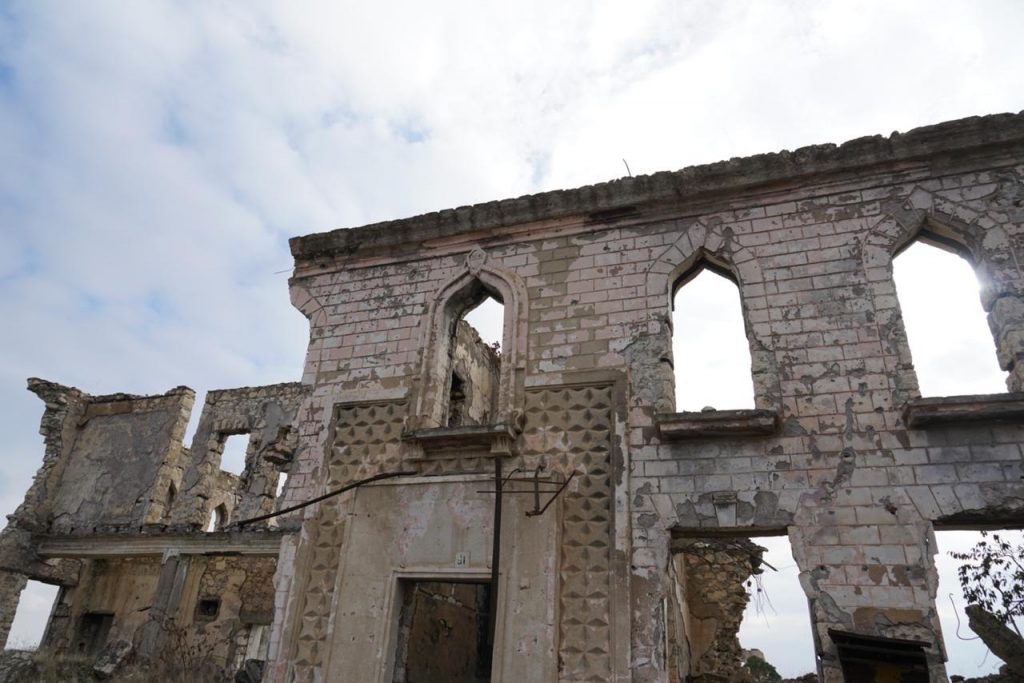When Armenia launched an armed assault against Azerbaijan on September 27 2020, it was already occupying 20 percent of Azerbaijani territory. Yerevan’s decision to fire on Azerbaijan’s civilian population in its military offensive prompted an armed response from Baku.
Over the next 44 days, Azerbaijan forces set out to end Armenian aggression and liberate the Nagorno-Karabakh region that had been unlawfully seized 30 years ago.
The rules of war clearly state that all parties must avoid harming civilians. Azerbaijanis were therefore shocked to see Armenian forces fire on areas outside of the conflict zone and deliberately target heavily populated civilian areas.
The world witnessed Armenian troops firing ballistic missiles at Ganja – Azerbaijan’s second largest city. Ganja is 100 kilometres away from the front line and had no military units that could be considered a legitimate target. Sadly Armenia didn’t stop there. They also fired on Barda, Tartar, Mingachevir, and other cities.
From the outbreak of the conflict in September until the signing of the peace agreement on 10 November, 93 Azerbaijani civilians were killed and 407 injured.
In addition, 504 civic buildings, 3,326 private houses, and 120 apartments were damaged in Azerbaijan as a result of Armenia’s targeting of densely populated areas.
Azerbaijan’s superior military capacity pretty much guaranteed a successful military operation in Karabakh, and six weeks after the conflict began a tripartite statement was signed on November 10 between itself, Armenia and mediator Russia. Essentially, occupying Armenia was forced to capitulate or suffer even greater losses.
Thus, Armenia was forced to evacuate Agdam, Kalbajar and Lachin without a fight. But this process was not carried out normally.
The animosity felt by Armenians towards their Azerbaijani neighbours is so great, that they chose to set fire to houses, and shoot cattle and other animals in the evacuated areas, instead of leaving them for returning Azerbaijanis, who had been displaced years before.
Armenians also caused major environmental damage, including the mass destruction of trees. All this happened before the eyes of the world media.
When Azerbaijani troops reached Aghdam, Fizuli, Jabrayil and other liberated cities, they found them wrecked by Armenians.
Garaxanbayli village of libarated Füzuli region. No solid building has been left. Vandalism did not know any limits. More crimes of Armenia will surface. International media well covers all warcrimes of Armenia. pic.twitter.com/iTLyC4EfZA
— Hikmet Hajiyev (@HikmetHajiyev) November 18, 2020
Residential buildings, historical monuments, museums and other buildings had been destroyed or looted. Many valuable artefacts were transported to Armenia during their 30 years of occupation.
More than 600 farms and industrial buildings, over 700 health facilities, and some 700 schools, along with national cultural heritage sites and mosques were smashed, while forest areas were obliterated.
While the international community focussed on whether Armenian religious and cultural heritage in Karabakh would be protected in the new era, there was scant concern for the heritage of Azerbaijanis.
A recent report titled ‘Damage to historical and cultural monuments in the occupied territories of Azerbaijan’, authored by Faig Ismayilov, head of the Public Union for the Protection of Historical and Cultural Monuments in the Occupied Territories of Azerbaijan, documents the extensive damage to monuments and sites that form a vital part of Karabakh’s cultural history and identity.
Only facade of building has been left in Füzuli. The scale and magnitude of destruction in deoccupied Fuzuli region of Azerbaijan shows how Armenia is far from civilized world. It is schorched earth policy. Vandalism and barbarism. pic.twitter.com/SVv3GPMn9e
— Hikmet Hajiyev (@HikmetHajiyev) November 18, 2020
Armenian aggression has led to widespread damage of historical treasures and cultural sites, including 13 internationally renowned, 292 nationally famed, and 330 locally important historical and cultural sites and monuments.
In addition, 22 museums with more than 40,000 exhibits, 927 libraries, 808 clubs, four theatres, two concert halls, 31 mosques, nine historical palaces, eight recreational parks, four art galleries, and 85 music schools were vandalised or ransacked, and in some cases, totally destroyed.
The Aghdam Bread Museum lays in ruins, while some 13,000 unique artefacts held in the Kalbajar Museum of History and Ethnography and more than 5,000 valuable exhibits of the Lachin Museum of History and Ethnography were illegally removed and now reside in Armenia.
Yet another sign of Armenia’s vandalism. Completely destroyed cemetery in Kurdlar village of Füzuli. @UNESCO pic.twitter.com/TEtt1S7b3G
— Hikmet Hajiyev (@HikmetHajiyev) November 22, 2020
As a result of the occupation of Shusha, eight museums, 31 libraries, 17 clubs, and eight houses of culture were destroyed, and multiple museums were looted.
Shusha’s History Museum and the Shusha branch of Azerbaijan State Museum of Azerbaijani Carpets and Applied Arts are missing over 5,000 exhibits, while 1,000 items have been stolen from the State Karabakh History Museum.
The memorial museums dedicated to genius composer Uzeyir Hajibeyli, great Azeri singer Buibul, and prominent musician and artist Mir Movsum Navvab, Agdam were vandalised, and funds intended for local history museums in Zangilan pilfered.
History and local folklore museums of Jabrayil, Fizuli and Khojaly regions were also destroyed.
After perpetrating such vandism to cultural and religious heritage of Azerbaijani people in occupied lands including in Ağdam Armenia doesn’t have even moral authority to speak about civilized attidute and cultural values. pic.twitter.com/1BMFXnuGHq
— Hikmet Hajiyev (@HikmetHajiyev) November 28, 2020
Armenians carried out illegal archaeological excavations in the occupied Azerbaijani lands, while also destroying graves and tombstones.
Environmental crimes were also committed in the occupied territories during these past three decades. Biodiversity in the region was destroyed, forests cut down, and mineral deposits plundered. Reservoirs and natural habitats were deliberately polluted.
It is often overlooked by international media, but as a result of Armenia’s brutal occupation of Nagorno-Karabakh a little under thirty years ago, tens of thousands of Azerbaijani citizens were killed and injured, and more than a million people displaced. The past and present leadership of Armenia are responsible for these crimes against humanity.
Hikmet Hajiyev, Assistant to the President of Azerbaijan, and Head of the Foreign Policy Department of the Presidential Administration, said that specialists were currently assessing these Armenian crimes. Their investigations are being supported by those in the private sector and international organisations and independent international institutions, which are all involved in the process of assessing the scale and impact of such wanton damage in Karabakh.
Magnitude of destruction in “Hiroshimo of South Caucasus” – Ağdam. Luckily Ağdam did not sustain nuclear attack. But damages and looting it has been inflicted by Armenia throughout of 30 years of occupational is worse than nuclear bomb. Vivid recognition of #urbicide pic.twitter.com/HfRJnm8Mw4
— Hikmet Hajiyev (@HikmetHajiyev) November 28, 2020
Azerbaijan President Ilham Aliyev’s decree envisages that once the general assessment of the damage and destruction is concluded, the details and value of the reparations will be presented to the international community through the Foreign Ministry, “Because each of these moments is a war crime.”
The latest report of the working group, established under Azerbaijan’s Cabinet of Ministers to assess the losses, shows that the damage to Azerbaijan is $819 billion. But this figure is growing – the Azerbaijan people will hold Armenia responsible for all their material and moral losses of these past 30 years.
These heinous acts have not only seriously harmed Azerbaijan, but also humanity, and the world should not remain indifferent to them. Terrorising civilian populations, and wilfully destroying the environment cannot be permitted.
The international media has a responsibility to report on these atrocities and to convey the truth of the events in Karabakh to the world community. A failure to do this risks setting a dangerous precedent for aggressors in other conflicts.
This article was written by journalist Ali Zulfugaroglu and research analyst Elnur Eltürk




